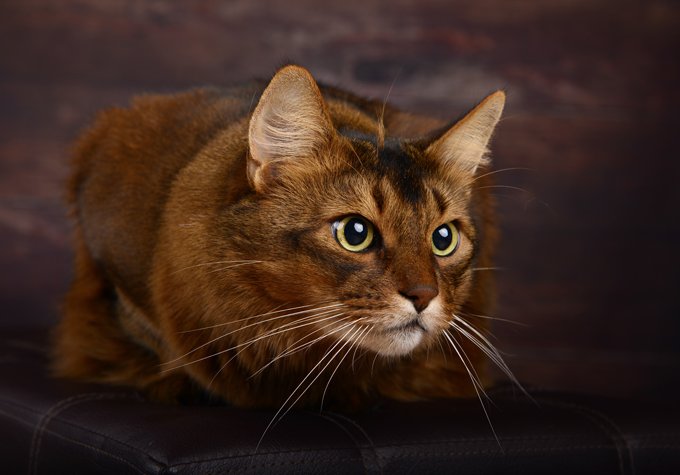This article courtesy of PetMD.com.
Obsessive-Compulsive Disorder (OCD) is a behavioral disorder where a cat will engage in repetitive, exaggerated behaviors that are seemingly without purpose. For example, grooming to the extent that fur is rubbed off; compulsive pacing; repetitive vocalizations; and eating, sucking, or chewing on fabric. If it continues over a long period of time, it may become fixed behavior, no longer requiring the situation or environmental trigger that started the behavior in the first place. The behaviors may reinforce themselves due to the release of pain-relieving chemicals in the brain. The behavior may become a mechanism for coping when the cat is confronted with conditions that conflict with its needs, and owners may be unintentionally reinforcing the behavior by giving the cat attention or food when it behaves compulsively.
Age and gender do not seem to be factors in compulsive behavior. Some breeds or family lines may be predisposed to behavioral compulsions, with Siamese and other Asian breeds overrepresented as commonly exhibiting repetitive meowing and fabric-chewing behavior.
Symptoms and Types
- Repetitive vocalization (meowing)
- Excessive grooming: May follow environmental change
- Compulsive pacing: May begin intermittently and increase in frequency
- Sucking: May be directed at a person or object, often begins spontaneously
- Fabric chewing: Some cats show preference for a specific type or texture, and some cats will even ingest the fabric
Causes
- Owner’s response plays a role in the compulsive behavior
- Behaviors may quickly increase in frequency if they are reinforced in some way by the owner, as with feeding or attention
- Stress due to changes in surroundings
- More common in indoor cats due to the stress of confinement
- Mental disorder
Diagnosis
Your veterinarian will perform a thorough physical exam on your pet, taking into account the background history of symptoms and possible incidents that might have precipitated this condition. The history you provide may give your veterinarian clues as to what is underlying your cat’s behavioral problems. A complete blood profile will be conducted, including a chemical blood profile, a complete blood count, and a urinalysis, in order to begin the process of confirming or ruling out physical and mental causes for the behavior. There may be an underlying illness, or, it may be in response to confinement, conflict, stress, anxiety, or frustration. If your doctor suspects neurological causes for the behaviors, a computerized axial tomography (CAT) scan, or a magnetic resonance image (MRI) can be used to examine the brain and spinal cord.
If there is excessive grooming behavior, your veterinarian will take skin scrapings for laboratory examination, and possibly a skin biopsy (tissue sample) in order to determine whether there are parasites or other detectable skin disorder. Skin reactions that appear to be food related will require diet modification in order to confirm the relation.

Your doctor will be most concerned with ruling out any medical causes, such as psychomotor seizures, before a definitive diagnosis is made. Following are some things your doctor will be taking into consideration:
- Itching:
- External parasites
- Fungal dermatitis
- Bacterial dermatitis
- Allergic dermatitis (including food allergies)
- Skin cancer
- Skin rash
- Pain:
- Nervous system disorders
- Rupture of a vertebral disc (spine) and associated inflammation of a nerve
- Acute sensitivity to touch or other stimuli
- Compulsive pacing:
- Normal sexual behavior
- Barrier frustration from confinement
- Nervous system disorders
- Chronic pain
- Brain lesions from tumors or trauma
- Following a seizure
- Metabolic and hormonal disorders
- Vitamin deficiency
- Liver disorder
- Hyperthyroidism
- Lead intoxication
- Kidney failure
- Thiamin deficiency
- Repetitive vocalization:
- Normal sexual behavior
- Hearing loss
- Hyperthyroidism
- Lead poisoning
- Hypertension
- Fabric sucking/chewing:
- Lead poisoning
- Hyperthyroidism
- Thiamin deficiency
Treatment
Reduce environmental stress. Regulate your cat’s schedule and increase the predictability of household events, such as feeding, play, exercise, and social time. Eliminate unpredictable events as much as possible. Confinement is not a good approach. For excessive grooming, topical deterrent agents are usually not effective. For compulsive pacing: do not allow your cat to go outside when the behavior starts, as it may reinforce the behavior. Try to let your cat out before the behavior begins. For repetitive meowing: breed or spay an intact female; castrate an intact male. For fabric chewing and sucking: keep the fabrics of interest out of your cat’s reach and increase dietary roughage.
Your veterinarian may prescribe some behavior-modification drugs, and will instruct you on how to use them. It is important to follow directions carefully, since accidental overdose is a common occurrence.
Living and Management
Try to ignore the unacceptable behavior as much as you can and do not reward it by responding. Take note of the details when your cat acts out: the time, place, and social situation, so that an alternate behavior, such as play or feeding, may be scheduled for that time. Punishment associated with the behavior increases the unpredictability of your cat’s environment and may increase fear and aggressive behavior. It also may disrupt your bond with your cat.
You will need to take your cat back to the veterinarian for follow-up examinations. If your cat does not respond to the treatment plan, the plan may need to be adjusted. If your cat is being medicated and there seems to be no progress, you will need to talk to your veterinarian about switching to a different drug.
You will also need to be realistic about improvement. Immediate control of a long-standing problem is not likely. Before you begin treatment, keep a record of the frequency of the behaviors that occur each week so that you can realistically measure progress.









